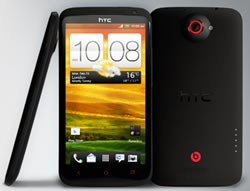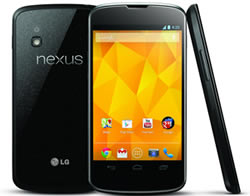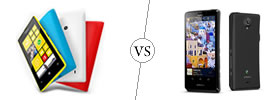Difference between HTC One X+ and Nexus 4
Key Difference: The HTC One X+ sports a 4.7-inch super LCD 2 touch screen with approximately 312 ppi pixel density, meaning the screen is pretty awesome and it does not show any pixels. The device is powered by 1.7 GHz Quad-core NVIDIA Tegra 3 process making it faster than the original HTC One X. The Nexus 4 is Google's fourth Nexus-branded Android smartphone. It was produced in collaboration with LG Electronics. The phone runs on the Android 4.2 (Jelly Bean) operating system, which was launched with the phone.

HTC is a popular smartphone company and has been touted for many beautifully designed phones. The phones are smart, sleek and to the point with no extra marketing gimmick. HTC maintains this with the launch of the HTC One X+. The HTC One X+ is a new phone that shares many similarities to its big brother the HTC One X; however, it also shines in many places where the predecessor shied. The HTC One X+ is basically an upgraded version of the HTC One X and hit the market in November 2012.
The HTC One X+ sports a 4.7-inch super LCD 2 touch screen with approximately 312 ppi pixel density, meaning the screen is pretty awesome and it does not show any pixels. The screen has excellent resolution and shows sharp and crisp clear photos and videos. The screen is protected by Corning Gorilla Glass 2 that keeps it from getting minor day-to-day scratches. The device is sleek and thin in general, but has put on a little extra weight (5 grams) compared to the original One X. The phone is covered in a soft-touch polycarbonate plastic chassis that has smooth curved corners. The soft matte plastic makes it easy to grip the phone and keeps it from slipping through the fingers. The phone comes incorporated with the HTC Sense UI v4+, which is basically a combination of the HTC Sense and Jelly Bean. The combination of the two provides additional features such as: Google Now, Voice search, faster screen navigation, new gallery app (organizes photos by events and location) and HTC Get Started (allows PC to configure the phone faster).
The device is powered by 1.7 GHz Quad-core NVIDIA Tegra 3 process making it faster than the original HTC One X. The faster processor allows seamless transitions between apps and makes the device smooth to work with. There was no hindering or jerking when operating the device. The One X+ comes installed with Android v4.1 (Jelly Bean) right out of the box. The device comes with 32 and 64 GB internal storage capacity that is not expandable and 1 GB RAM.
The device houses an 8 MP rear camera with auto focus, LED flash, and BSI sensor, along with a 1.6 MP front camera for video conferencing. The front camera also has a countdown features that counts down to the moment the picture is being taken to ensure that the user is camera ready. The camera comes with many additional features that help the phone stand out against all the other devices. The features include: F2.0 aperture and 28mm lens, Dedicated HTC ImageChip, VideoPic, Continuous shooting, Smart Flash, Sightseeing mode, Video stabilization, Slow motion video capture and playback and ImageSense. The ImageSense allows the phone to take faster and the best photos under any lighting. The VideoPic is a new feature that allows users to take images while recording a video as well as taking an image when playing an already recorded video. The Smart Flash provides five levels of flash that adjust automatically when trying to take a shot, while the Sightseeing mode allows the camera to be handy during outings, so that it can be easily accessible.
The device houses a non-removable 2100 mAh Lithium-ion Polymer battery, which according to tests by many review website, dies pretty quickly. When fully-working the battery does not even last a whole day. However, no official data has been released by the company regarding the Talk-time and the Stand-by time. The company has also added the Beats Audio sound enhancement to its speakers as well as headset and it can be turned on and off by the user. The phone has been a popular hit with many that require a good sturdy budgeted phone with an excellent camera.

A number of these companies’ smartphones and tablets run on Android. Android is an open source software, which means that the code is freely available for modification and distribution by device manufacturers, wireless carriers and enthusiast developers. Among the number of various companies, Google has also launched its own line of smartphones based on Android, called the Google Nexus. Each device in the Nexus line is produced via collaboration between Google and a leading original equipment manufacturer (OEM) partner.
The Nexus devices in general have an advantage over other devices in that the Android in the Nexus devices is pure, i.e. the Android does not have any manufacturer or wireless carrier modifications to it, such as a custom graphical user interface. The Android also has an unlockable bootloader to allow further development and end-user modification, all of which is usually blocked on other Android smartphones.
The Nexus 4 is Google's fourth Nexus-branded Android smartphone. It was produced in collaboration with LG Electronics. The phone features a 1.5 GHz quad-core Snapdragon S4 Pro processor, 2 GB of RAM, 8 or 16 GB of internal storage, front facing 1.3 megapixel camera and an 8 megapixel rear camera and a micro-SIM card tray. The phone runs on the Android 4.2 (Jelly Bean) operating system, which was launched with the phone. The phone also features a new camera technology, called the Photo Sphere. This allows one to take 360 deg Panorama shots.
The information for the detailed table about the two phones has been taken from HTC website, Google website, knowyourmobile.com, expertreviews.co.uk and GSMArena.com.
|
|
HTC One X+ |
Nexus 4 |
|
Launch Date |
November 2012 |
November 2012 |
|
Company |
HTC |
Google; designed in collaboration with and manufactured by LG Electronics. |
|
Size |
134.36 x 69.9 x 8.9mm |
133.9 x 68.7 x 9.1 mm (5.27 x 2.70 x 0.36 in) |
|
Display |
4.7 inch super LCD 2 touch screen |
4.7 inches True HD IPS Plus capacitive touchscreen, 16M colors |
|
Screen |
720 x 1280 pixels (~312 ppi pixel density) |
768 x 1280 pixels, (~318 ppi pixel density) |
|
Protection |
Corning Gorilla Glass 2 |
Corning Gorilla Glass 2 |
|
Weight |
135 grams |
139g (4.90 oz) |
|
2G Network |
GSM 850 / 900 / 1800 / 1900 |
GSM 850 / 900 / 1800 / 1900 |
|
3G Network |
HSDPA 850 / 900 / 1900 / 2100 HSDPA 850 / 1900 / 2100 - for AT&T |
HSDPA 850 / 900 / 1700 / 1900 / 2100 |
|
4G Network |
LTE 700 MHz Class 17 / 1700 / 2100 - for AT&T |
No |
|
GUI |
HTC Sense UI v4+ |
Pure Android |
|
CPU speed |
1.7 GHz Quad-core NVIDIA® Tegra® 3 |
Quad-core 1.5 GHz Krait |
|
GPU |
ULP GeForce 2 |
Adreno 320 |
|
OS |
Android OS, v4.1.1 (Jelly Bean) |
Android OS, v4.2 (Jelly Bean), upgradable to v4.2.2 (Jelly Bean) |
|
Chipset |
NVIDIA Tegra 3 AP37 |
Qualcomm APQ8064 Snapdragon |
|
RAM |
1 GB |
2 GB RAM |
|
SIM Size |
microSIM |
microSIM |
|
Internal Memory |
32/64 GB |
8/16 GB storage |
|
Expandable Memory |
No |
No |
|
Sensors |
Gyro sensor, G-Sensor, Digital compass, Proximity sensor, Ambient light sensor |
Accelerometer, gyro, proximity, compass, barometer |
|
Connectivity |
3.5 mm stereo audio jack, NFC capable, Compliant with Bluetooth 4.0, Bluetooth with aptX™ enabled, Wi-Fi®: IEEE 802.11 a/b/g/n, DLNA®, micro-USB 2.0 (5-pin) port with mobile high-definition video link (MHL) for USB or HDMI connection |
WiFi 802.11 a/b/g/n, Bluetooth, NFC (Android Beam), Unlocked GSM/UMTS/HSPA+, GSM/EDGE/GPRS, 3G, HSPA+ 42, Wireless charging, SlimPort (TM) |
|
Data |
GPRS, EDGE, WLAN, Bluetooth, NFC, USB. |
WiFi, NFC, GPRS, EDGE, USB |
|
Speed |
HSDPA, 21 Mbps; HSUPA, 5.76 Mbps - Global version / HSDPA, 42 Mbps; HSUPA, 5.76 Mbps; LTE |
DC-HSDPA, 42 Mbps; HSDPA, 21 Mbps; HSUPA, 5.76 Mbps |
|
WLAN |
Wi-Fi 802.11 a/b/g/n, dual-band, DLNA, Wi-Fi hotspot |
Wi-Fi 802.11 a/b/g/n, dual-band, DLNA, Wi-Fi hotspot |
|
Bluetooth |
Bluetooth v4.0 with A2DP |
Bluetooth v4.0 with A2DP |
|
USB |
microUSB v2.0 (MHL) |
microUSB (SlimPort) v2.0 |
|
Primary Camera |
8 MP camera with auto focus, LED flash, and BSI sensor |
8 MP, 3264 x 2448 pixels, autofocus, LED flash, check quality |
|
Secondary Camera |
1.6 megapixel front camera (720p for video recording) |
1.3 MP |
|
Video |
1080p HD video recording |
1080p@30fps |
|
Camera Features |
|
|
|
Sound Enhancement |
Beats Audio |
SNS integration Active noise cancellation with dedicated mic |
|
Audio supported formats |
.aac, .amr, .ogg, .m4a, .mid, .mp3, .wav, .wma |
MP3/WAV/eAAC+/AC3 player |
|
Video supported formats |
.3gp, .3g2, .mp4, .wmv (Windows Media Video 9), .avi (MP4 ASP and MP3) |
MP4/H.264/H.263 player |
|
Battery Capacity |
Non-removable 2100 mAh Li-ion Polymer battery |
2100 mAh battery |
|
Talktime |
No official data released |
No official data released |
|
Standby Time |
No official data released |
No official data released |
|
Available Colors |
Black, White |
Black |
|
Messaging |
SMS(threaded view), MMS, Email, Push Mail, IM, RSS |
SMS(threaded view), MMS, Email, Push Mail, IM, RSS |
|
Browser |
HTML5, Adobe Flash |
HTML5 |
|
Radio |
Stereo FM radio with RDS |
No |
|
GPS |
GPS with A-GPS support and GLONASS |
A-GPS support and GLONASS |
|
Java |
Java with Java MIDP emulator |
Java MIDP emulator |
|
Additional Features |
|
|
Image Courtesy: htc.com, battellemedia.com









Add new comment